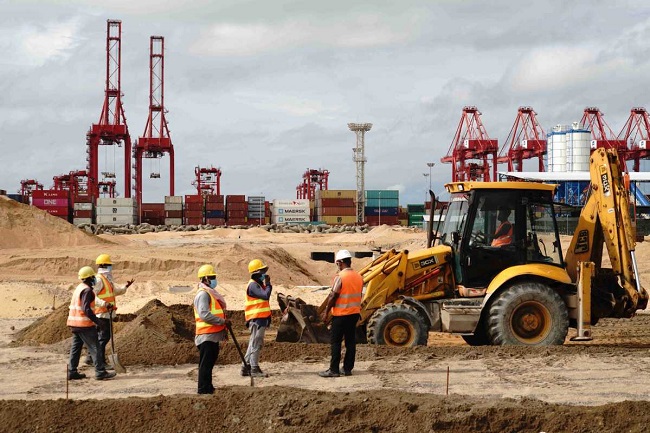China's long-term goals to help BRI development

Workers undertake construction at a harbor in Colombo, Sri Lanka, a project under the Belt and Road Initiative and commissioned by China Harbour Engineering Co Ltd, in September, 2020. [Photo/Xinhua]
China's Five-Year Plan announced by Premier Li Keqiang at the National People's Congress has attracted the attention of international community.
The blueprint of China's development course in the next 5 years and long-term objectives through 2035 carry many opportunities regarding cooperation and progress domestically and internationally.
After the sudden outbreak of COVID-19, global economic system faced uncertainty and hardships as the economic growth of various major countries turned into negative.
China was the first country to face the worst, but with the quick and effective response led by President Xi Jinping, China mobilized all the resources and contained the pandemic and its negative impact on the second-largest economy of the world.
Meanwhile, the only major initiative that remained unaffected by COVID-19 and delivered positive outcome was the Belt and Road Initiative.
None of the key projects involved in China-proposed BRI have been suspended due to COVID-19 and the functionality of the initiative helped partner countries to restore jobs to workers at a time when international labor was losing jobs.
China's imports and exports to countries and regions involved in the Belt and Road routes reached 9.37 trillion yuan ($1.45 trillion) in 2020, up 1 percent year-on-year, in which epidemic-related personal protection equipment items accounted for a significant proportion, Chinese customs data showed.
Chinese overseas investments into countries and regions of the BRI were about $47 billion in 2020 and the countries and regions of the BRI were less affected by the slowdown of Chinese overseas investments compared to non-BRI partners.
The operations of the BRI helped the partner countries to counter the financial weaknesses created by COVID-19 last year.
Now the next five-year plan and long-term objectives through 2035 show that shared future of mankind will be pushed forward for establishing a common destiny to achieve sustainable development and goals.
It shows that at the crossroad of the economic globalization, the BRI is playing a significantly leading role in tackling trade protectionism.
The initiative has been successfully creating an open, inclusive and shared economic globalization based on win-win situation for all.
In the recent past, the initiative has undertaken three historical tasks for partner countries: the interconnectivity of infrastructure, focus on capacity cooperation and service trade, and establishing a multilevel and diversified free trade area networks.
It has also recorded a new mission of creating free zone trade network that has been accelerating a global free trade process without any interruption.
The long-term objectives announced means that the BRI will continue to develop large platforms, large channel and large layout of China's opening-up that will help the domestic development of partner countries.
All relevant sectors received BRI investments in 2020 including infrastructure, particularly energy and transport with the share of investments in transport and energy infrastructure increasing from about 70 percent in 2019 to almost 80 percent in 2020.
Among the BRI countries, investments were recorded in various countries in different continents while most share of investments were done in Vietnam, Indonesia, Pakistan and Chile.
As per the estimation it is expected that China will be investing more on strategic assets such as ports, regional transport infrastructure, agricultural development, high-speed railways, technological development and vocational development in partner countries under the BRI platform.
Multilateral trade agreements such as Regional Comprehensive Economic Partnership will be pushed forward among member countries to share the economic achievements and progress in various sectors that will facilitate the volume of trade.
More of developing countries who are already member of BRI are in a dire need of investment in energy resources for tackling their shortages in energy sector.
The main objective of the BRI to explore the full potential of member countries will be achieved in the next years and the goal for securing the realization of common prosperity will be gained on priority basis consistently.
The expectations of member countries from China about the BRI are high that will enable billions of people to get more opportunities of stable employment, better living standards, green development and better healthcare.
The needs of sustainable development for local people in various countries will be fulfilled in a more dignified way without attaching any political strings to it.


